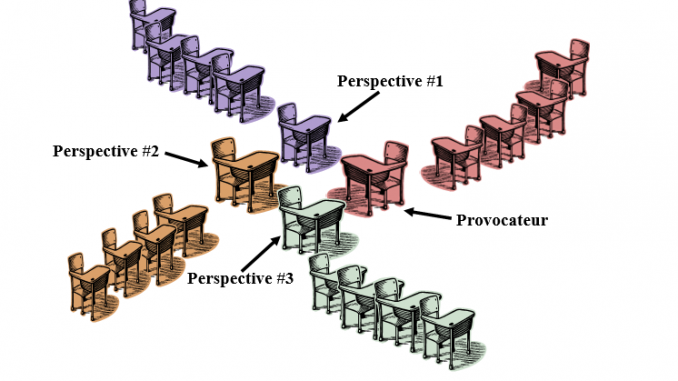
What is it?
Pinwheel discussions are often used to consider and discuss a topic from different perspectives and points of view. They can be used when there is an particular topic or controversial question to discuss, such as medical ethics, causes and solutions of climate change or negotiating military strategy. They can be used to represent different roles in a meeting Indeed, they can be used in any discipline, module or topic area where there might be more than one view,role, perspective, cause or solution.
Why do it?
The pinwheel hones argumentation skills and critical thinking, like debating, but, unlike debating, allows for multiple competing perspectives rather than a dichotomy. They have been used in literature and history classes to help with understanding of events (real or fictional) and their protagonists. In this way, they can be used to develop skills of empathy. In clinical education classes or law for example, they can be used to discuss topics from a human perspective by playing roles (mother, doctor, father, midwife of a sick infant).
Pinwheels can be used with larger cohorts because the discussion involves the whole room.
This could be a nice way to prepare students for a course assignment which requires analysis or evaluation of different sources, views etc.
How to set it up?
- Divide students into groups, one for each perspective etc you wish to represent. It is common in most pinwheels to have one additional group of students selected to be “Provocateurs.” who facilitate and keep the discussion going. You, or a GTA, can take this role yourself initially if you feel students need more support.
- Give each perspective group some time to prepare, discuss and summarise their point of view regarding the set question/issue, and prepare some main arguments (in a similar way to a debate). If you wish them to use texts, give some time to identify parts of the text that supports their points. “Provocateurs” will also need time to create (text-based) questions to set off and manage the discussion. They should examine texts to develop questions that compare, analyze, and challenge the perspectives identified.
- Each group will nominate its first ‘Speaker’, who sits facing the other groups’ first Speakers and a Provocateur, so they form a square knee-to-knee in the centre of the room. See the diagram above. The remaining group members are seated BEHIND each first Speaker: two right behind the speaker, then three behind them, and so on, forming a kind of triangle. From a bird’es eye view, this would look like a pinwheel! The Provocateur starts off with a question which the three Speakers discuss in character, representing that viewpoint.
- After a specified time, new students rotate from the seats behind their Speakers (and Provocateurs if this is a separate group) into the centre seats and continue the conversation.
- The tutor can keep a record on the board of helpful moves in the discussion, such as evidence, follow-up questions, or new ideas. You can also nominate a student to do this, or ask for a volunteer.
- Give some time at the end of the session for students to reflect on the discussion and .or for the tutor to feed back ion key points arising. As a bridging activity, extension or formative assignemnt, you can ask studnets to prepare a summary of the discussion, or write a short essay on their own response to the question while considering other perspectives.
Considerations
- If you expect students to be able to use texts and sources as evidence for their roles, do make this clear beforehand. You might want to spend some time before setting up the discussion clarifying any issues with sources, including how to refer to sources in spoken discussion.
- The success of the pinwheel largely depends on the time taken to set up and relies on a large amount of class time, so although works with large classes, it is perhaps is best done in seminars or the second half of longer lectures. To speed up the process, assign students groups before the class so they can prepare together, and you could assign pre-prepared questions to the Provocateur group ( although be careful as this does take the critical element out of the activity somewhat).
- If you require pre-class preparation, do explain the purpose of the task and what they will do in class beforehand, to ensure full engagement with preparation.
- Set up the expectations beforehand in whether you require students to present the most convincing arguments, or whether this is merely an opportunity to air different analytical lenses. this will of course depend on the topic/question as to whether you require one definitive ‘winner’ of the discussion.
Examples and references
- In action: a video of the pinwheel variation in Sarah Brown Wessling’s literature classroom:
- Source: Cult of Pedagogy.
- Source: Social Studies Toolbox
- Image source: https://socialstudiestoolbox.pbworks.com/w/page/108678058/Pinwheel%20Discussion

Leave a Reply